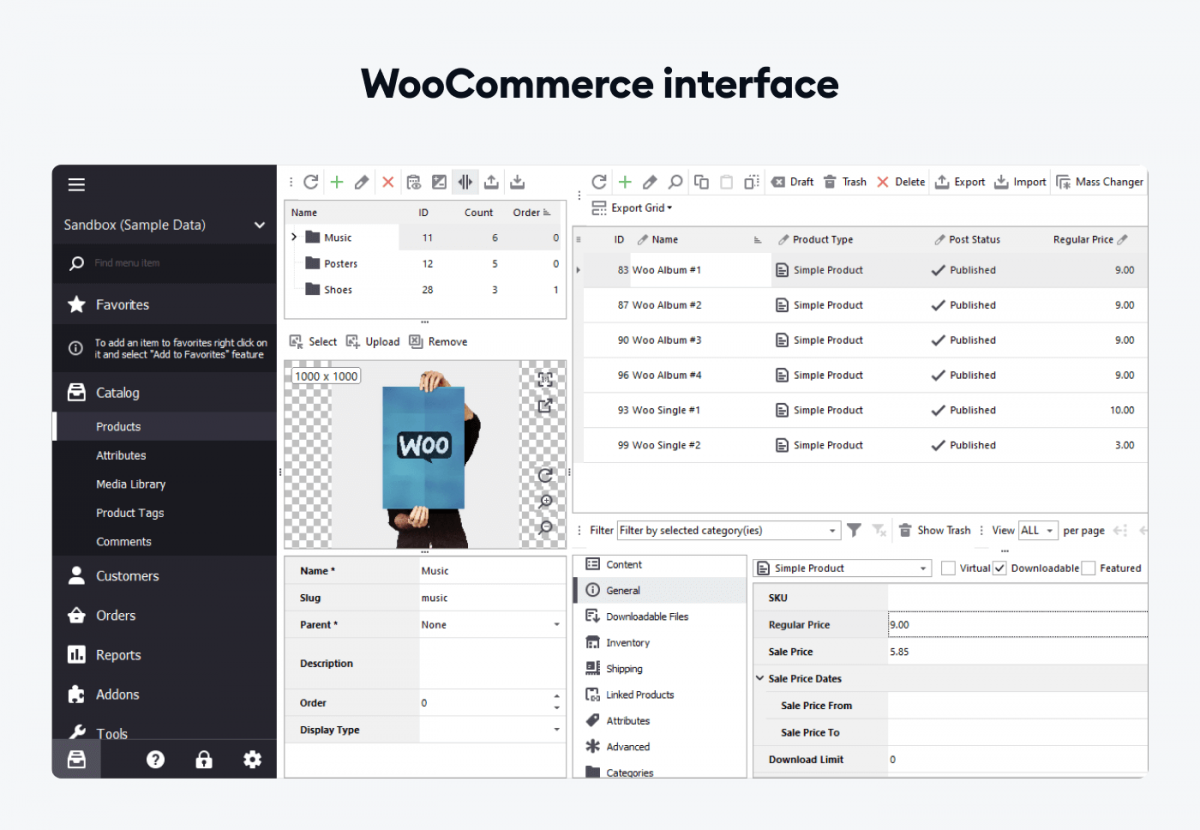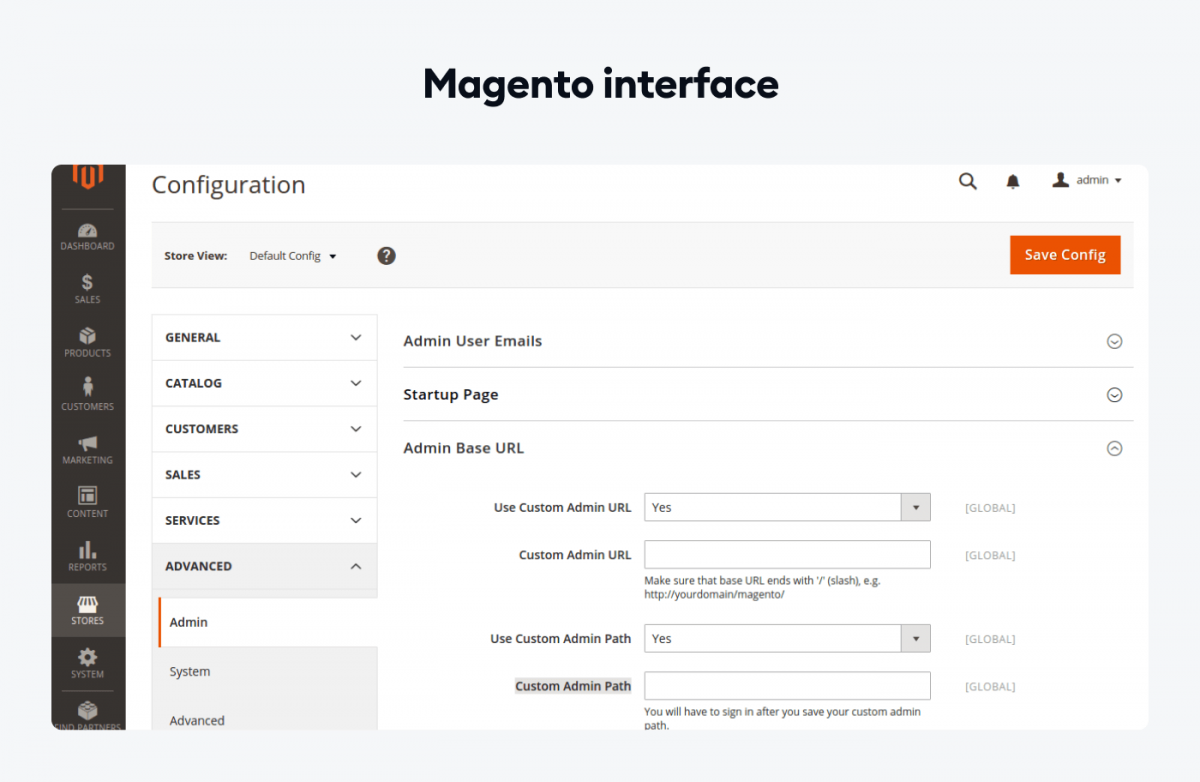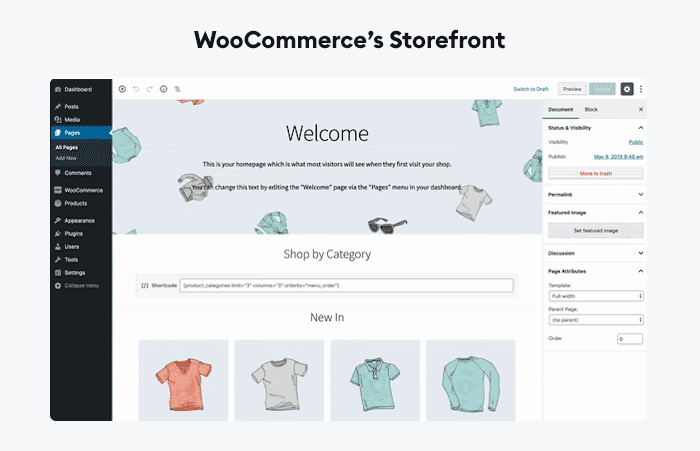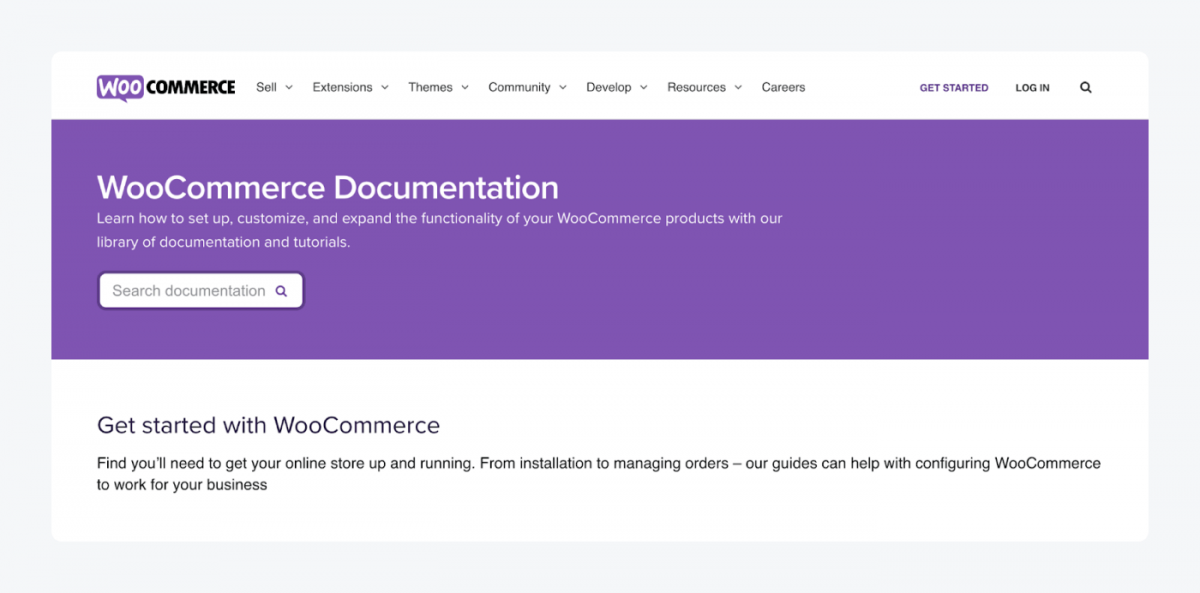WooCommerce vs Adobe Commerce (formerly Magento)—both are ecommerce giants with a variety of robust features. Both have plenty of supporters, swearing by their performance.
This is why choosing the best one for your business might be confusing.
Don’t worry—
This is where we step in.
Learn first-hand account of how Tidio helped Shockbyte grow
Main differences
Adobe Commerce and WooCommerce are both popular ecommerce platforms on the market.
BuiltWith reports that in 2020, there were approximately 170,000 websites built with Adobe Commerce, which makes 1.4% of all websites on the internet. WooCommerce, on the other hand, is powered by WordPress, the most popular CMS in the world, hosting over 28M websites.
So… What are the main differences between Adobe Commerce vs WooCommerce?
Adobe Commerce is designed with scalability in mind. It’s tailored to professionals, which is why the biggest global brands (like Moschino, Coca-cola, or Swatch, just to name a few) use it.

WooCommerce is a powerful plugin that transforms your WordPress site into an ecommerce store. It is much more accessible and significantly more affordable, while still offering limitless customization and flexibility.

We’ve looked into the pros and cons of Adobe Commerce and WooCommerce and analyzed different aspects to give you an in-depth comparison review.
But before we jump into the in-depth analysis of every functionality, have a look at our Adobe Commerce to WooCommerce comparison table:
Feature comparison: WooCommerce vs Adobe Commerce
| WooCommerce (5/8) 🏆 | Adobe Commerce (3/8) | |
|---|---|---|
| Pricing | Open-source platform with relatively low costs 🏆 | An open-source platform, but with high costs of maintenance and extras |
| Extensions and plugins | Over 50k integrations and plugins, those that are paid are relatively low-cost 🏆 | Offering around 1,900 free extensions, but those that are not free are expensive |
| Setup time and ease of use | Requires basic technical skills to set up with WordPress. Relatively easy to use. 🏆 | A complex installation process for more tech-savvy users. |
| Design and themes | One basic theme to customize. On top of that: 20 templates to choose from, 13 responsive, 3 free. Paid themes range between $39 and $79 🏆 | 2 basic themes. 10 paid themes ranging from $17 to $399. |
| Security | All security features must be sourced, usually by a web-hosting provider | Automatically PCI-compliant. Adobe Commerce comes with two-factor authentication. Regularly released security patches 🏆 |
| Transaction fees and payment options | No transaction fees, 3 payment methods, 3 payments gateways | No transaction fees, 5 payment options, 2 payment gateways 🏆 |
| Inbuilt features | A wide variety of built-in SEO features | Built-in inventory, sales, SEO, and analytics features, efficient API 🏆 |
| Customer Support | Extensive knowledge base and the possibility to fill the ticket, no official 24/7 support 🏆 | Extensive knowledge base, active user community |
As you can see from the table above, we favored WooCommerce over Adobe Commerce. But you need to remember that every business is different! That’s why it’s worth deep-diving into each aspect.
Pricing
For many ecommerce store owners, pricing is one of the main considerations when choosing the right platform. Who’s the winner—Adobe Commerce or WooCommerce?
🏆 The winner in this category is: WooCommerce
Why?
It costs between $14-$30 per month to cover its basic features, and between $200-$1,000+ a year if you want to go extra. This makes for around $1.5k a year on average. On the other hand, Adobe Commerce costs can easily go up to $15k in a year.
| 🏆 WooCommerce Pricing | Adobe Commerce Pricing |
|---|---|
| – Dedicated hosting plan powered by Bluehost: Starter: $13.99/month Plus: $17.99/month Pro: $31.99/month – Security: $0-$200/year – Domain: $10-$20/year – Extension fees: $0-$100/month | – Dedicated hosting solution powered by Siteground: Start-up: $14.65/month Grow big: $25.94/month Go Geek: $39.47/month – Developers’ costs: around $2k per job – Domain: $10-15/year – Extension fees: up to $499/year |
The main difference
Both platforms are open-source and in both cases you’ll have to pay extra for setting up the store and installing additional plugins. However, Adobe Commerce is mainly for big stores with advanced functionalities that usually require programming work. This means that if you want to customize and modify your Adobe Commerce store to your liking, you need to hire developers. And it’s not that cheap—experienced Adobe Commerce developers ask for around $2,000 a job.
Where does WooCommerce beat Adobe Commerce?
WooCommerce’s prices are way more accessible. Fixed costs such as domain hosting and security are relatively low and even if you install extra plugins (on average, $39 per extension), you can still spend less than using Adobe Commerce.
Plugins and extensions
Sometimes, the basic functionalities of an online ecommerce solution are not enough. This is where plugins and extensions come in. They let you add functionalities that improve customer experience, reinforce your marketing strategy and even increase sales.
Good to know…
The main difference between the plugin and extension is that the plugin provides extra functionality that doesn’t modify the core functionality. Extensions are made for modifying core functionality.
🏆 The winner in this category is: WooCommerce
Why?
Using plugins for most of the functionalities lies at the core of WooCommerce. A lot of them are free and the majority of them are easy to install, modify and maintain. In comparison, the prices for Adobe Commerce plugins and extensions are usually higher.
| 🏆 WooCommerce | Adobe Commerce |
|---|---|
| – 50k plugins – Almost all plugins integrate seamlessly with the platform | – 3,500 extensions in total including – 1,900 free They require monitoring during the updates – Paid extensions are relatively expensive |
The main difference
Customization is both WooCommerce’s and Adobe Commerce main selling point. It’s only logical that they both integrate with a vast amount of extensions and plugins seamlessly. But even though Adobe Commerce has more extensions than WooCommerce, the latter’s users have the entire library of WordPress plugins at their disposal.
Where does WooCommerce beat Adobe Commerce?
Adobe Commerce extensions are easy to install, but they can cause quite a few problems during updates. When it comes to add-ons, they can be troublesome in maintenance, and Adobe Commerce users are required to know how to modify them. On top of that, the same integration plugins are very often double or triple the price for Adobe Commerce as compared to WooCommerce. For example, the Instagram integration plugin for WooCommerce costs $79 a year, while for Adobe Commerce, it’s $300 a year. All this makes WooCommerce a better choice.
Suggested read
Discover top WooCommerce plugins and extensions.
Good to know…
Both Adobe Commerce and WooCommerce easily integrate with Tidio, a customer service platform offering chatbots for abandoned cart recovery. See how to install Tidio on Adobe Commerce and how to install Tidio on WordPress.
Learn how Tidio helped Shockbyte improve customer satisfaction
Setup time and ease of use
The best ecommerce platform enables you to quickly move from a traditional brick-and-mortar shop to an online business. The ease of use and maintenance can also be decisive criteria, especially for small businesses.
🏆 The winner in this category is: WooCommerce
Why?
WooCommerce is much more accessible than Adobe Commerce, both in terms of installation and user-friendliness.
| 🏆 WooCommerce | Adobe Commerce |
|---|---|
| – Manual setup with guidance – WordPress wizard – For tech-literate users | – Complex, manual setup – Less accessible, with a steeper learning curve – For tech-savvy users |
The main difference
Manual installation is necessary in both cases. However, WooCommerce users can fall back on the WordPress installation wizard, making the process much easier. In contrast, Adobe Commerce requires more dedication, skills, and tech-savviness.
Using both platforms is intuitive, making online store management relatively easy.


The problems appear when you need to use more advanced features or customize the shop to your liking—this is when an experienced Adobe Commerce developer comes in handy.
Where does WooCommerce beat Adobe Commerce?
A WooCommerce store requires basic tech skills, but the installation and setup are definitely less tricky than in the case of Adobe Commerce.
Customization and store optimization are also more user-friendly and, overall, easier for an average user. So even if the platform requires basic technical skills for comfortable management, it’s a definite winner in this category.
Design and themes
Did you know that 42% of consumers won’t purchase from a website they consider ugly, and 75% of your visitors will judge your credibility by your website? These are two excellent reasons to take the subject of themes and design seriously.
🏆 The winner in this category is: WooCommerce
Why?
| 🏆 WooCommerce | Adobe Commerce |
|---|---|
| – 20 built-in themes(13 responsive, 3 free) – Paid themes by external designers available ($39-$79) – Highly customizable | – 2 built-in themes – Possibility to create your own theme from scratch – Paid themes cost $17-$399 – Requires coding |
The main difference
WooCommerce offers around 20 built-in themes, including a popular entry theme, Storefront. Adobe Commerce offers only two themes: Luma (demo theme) and Blank—the basis for custom creations.


Where does WooCommerce beat Adobe Commerce?
In the case of Adobe Commerce, you can customize the Blank theme from scratch or use additional page-building tools. WooCommerce will make your ecommerce customization a little bit easier. To edit WooCommerce’s layouts, you can install custom WordPress plugins. You will need some tech skills and basic IT literacy, but it’s still easier than doing it on Adobe Commerce. This might be especially important for small businesses that might not want to consult an IT specialist every time the theme needs tweaking.
Good to know…
Users who want to buy an attractive-looking theme that doesn’t look random can visit Themeforest—one of the biggest markets for ecommerce business themes. There, you can find paid and free themes, both for Woo and Adobe Commerce.
Suggested read
Want to get inspired? Check out the best free WordPress themes.
Security
As many as 51% of consumers would leave the website if it doesn’t have the SSL certificate. They are right—security is a must when it comes to ecommerce. Remember that apart from processing payments, you also store your customers’ personal info. Let’s investigate which platform offers more advanced security measures.
🏆 The winner in this category is: Adobe Commerce
Why?
In contrast to WooCommerce, Adobe Commerce comes with a number of advanced security features.
| WooCommerce | 🏆 Adobe Commerce |
|---|---|
| – Self-hosted – SSL certificate must be sourced by a web hosting party (for example, Bluehost) – You need to make it PCI-DSS compliant manually | – Automatically PCI-compliant – Regularly released security patches – Site security scanner – Extra safety measures coming with Siteground hosting: free SSL certificate, 24/7 server monitoring, intrusion blocker |
The main difference
SSL (Secure Sockets Layer) safeguards personal information from being stolen, and PCI-DSS (Payment Card Industry Data Security Standard) enables you to process credit card payments legally. Both Adobe Commerce and WooCommerce are self-hosted platforms, which means you are responsible for providing these security measures yourself. However, Adobe Commerce comes with a few extra built-in features that WooCommerce lacks.
Where does Adobe Commerce beat WooCommerce?
The latest Adobe Commerce version comes with two-factor authentication and is automatically PCI-compliant. On top of that, Adobe Commerce releases security patches, regular software updates that keep your website safe. You can also check your website for weak spots with a security scanner.
If you are hosting your Adobe Commerce store with Siteground, a dedicated hosting provider, you also get:
- Free SSL certificate
- Server monitoring
- Intrusion prevention system, which blocks the IPs that tried password scraping
WooCommerce requires a manual installation of the PCI-DSS and an SSL certificate. This makes it significantly less robust when it comes to security.
Suggested read
See how Tidio handles security measures.
Transaction fees and payment options
🏆 The winner in this category is: Adobe Commerce
Why?
It offers more payment methods, and it’s possible to add many more gateways through extensions.
| WooCommerce | 🏆 Adobe Commerce |
|---|---|
| – Four payment methods: online card payment, check payments, cash on delivery, direct bank transfer – Three payment gateways: Paypal, WooCommerce Payments, Braintree – Possibility to add more gateways – Apple Pay supported – No transaction fees | – Six payment methods: online card payment, check/money order, cash on delivery, bank transfer, purchase order, zero subtotal checkout – Two payment gateways: Paypal and authorize.net – Possibility to add gateway extensions ($0-$100 per extension): Stripe, Square, Amazon Pay. – Apple Pay not supported – No transaction fees |
The main difference
Both platforms easily integrate with various add-ons and extensions to provide multiple payment gateways. Neither of them charges extra transaction fees, but Adobe Commerce has more payment methods, making it a little more flexible than WooCommerce.
Where does Adobe Commerce beat WooCommerce?
Adobe Commerce has a wider choice of payment methods and offers a variety of extensions for payment gateways. Even though Adobe Commerce paid extensions are usually more expensive than those for WooCommerce, Adobe Commerce offers more flexibility and comes out on top.
Good to know…
WooCommerce provides a native payment solution, WooCommerce Payments. Its primary purpose is to manage all transactions from one dashboard.
Built-in features
Both Adobe Commerce and WooCommerce are built with customization in mind. But which platform comes with more features?
🏆 The winner in this category is: Adobe Commerce
Why?
Adobe Commerce comes with many more features out of the box than WooCommerce.
| WooCommerce | 🏆 Adobe Commerce |
|---|---|
| – Few standard sales features: embedding suggested products on different product pages, one-click refund, possibility to customize the checkout – Advanced SEO tools – A variety of paid add-ons available | – Advanced analytics – Advanced SEO tools – Inventory management: customer logins, product comparisons, anchor menus, wish lists, gift card payments, and staff logins – Sales of all product types |
The main difference
WooCommerce integrates with a wide variety of add-ons and plugins, which allows for more freedom when it comes to modifying the store. However, Adobe Commerce comes packed with useful features out of the box, and on top of this, you can add extensions for even more customization. This tips the scales in Adobe Commerce favor this time around.
Where does Adobe Commerce beat WooCommerce?
Adobe Commerce offers many more advanced features: from optimizing your store for search engines to sales features.
Customer support
Both platforms are relatively easy to use, but some ecommerce owners may need help when it comes to order management, currencies, or setting up payment options. Let’s see which platform provides the best customer support.
🏆 The winner in this category is: WooCommerce
Why?
Neither WooCommerce nor Adobe Commerce has official customer support, but the possibility to submit a support ticket for WooCommerce makes it a winner.
| 🏆 WooCommerce | Adobe Commerce |
|---|---|
| – Ticket support – Vast knowledge center and library of tutorials – Dedicated forums | – Adobe Commerce community – FAQs – Best practices and tips |
The main difference
Neither WooCommerce nor Adobe Commerce has its own customer support team that can be contacted in case of an issue. WooCommerce offers a vast library of guides and documents.

Adobe Commerce open-source software has an active community of users you can ask for help. Adobe Commerce users say that you can solve almost any issue with the community’s help.

Where does WooCommerce beat Adobe Commerce?
The possibility to submit a ticket for review in the case of WooCommerce makes it more appealing, especially for small and medium businesses.
Good to know…
You can contact customer support regarding WooCommerce if you use the services of their dedicated hosting provider, Bluehost. Similarly, you can contact the support team of Sitefront to resolve the issue about Adobe Commerce
Suggested read
Discover how to deliver good customer service.
Who should use what?
Comparing WooCommerce to Adobe Commerce might leave you feeling slightly overwhelmed. This is why we prepared a little cheat sheet. Have a look and see how many positions you can tick on each side!
| Use WooCommerce if you… | Use Adobe Commerce if you… |
|---|---|
| – Want to build your store on top of your WordPress website – Build your store by yourself – Have up to a few hundred products on your site – Can survive having no customer support 24/7 | – Already hire developers or don’t mind paying additional money for some work to be done – Own a global multi-store that is enterprise-sized – Plan to have thousands of products – Are tech-savvy and don’t mind taking care of the back-end |
WooCommerce vs Adobe Commerce: Summary
By now, you should have a clear overview of both Adobe Commerce and WooCommerce. Let’s recap the most important info:
- Both WooCommerce and Adobe Commerce are self-hosted platforms, which means you will need to use third-party hosting services.
- You’ll need basic technical skills to set up both Adobe Commerce and WooCommerce However, the WooCommerce setup process and overall ease of use are tailored to less tech-savvy users.
- WooCommerce is ultimately a less costly solution, as opposed to Adobe Commerce.
- Adobe Commerce is more robust when it comes to out-of-the-box features (such as sales and marketing), and it also offers more payment options.
- Adobe Commerce will be an optimal solution for medium and large businesses.
- WooCommerce is more accessible for small companies.
If you need help with adding live chat and chatbots to your WooCommerce or Adobe Commerce, don’t hesitate to write to us.
We integrate with both!

